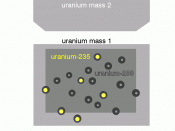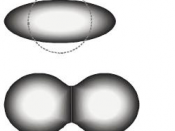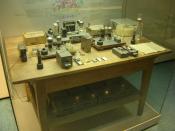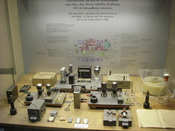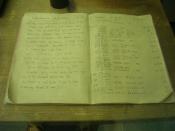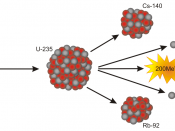Nuclear fission, a fairly recent discovery, is a process in which an atom is split by the collision of two subatomic particles. There are many components needed to successfully obtain nuclear power by nuclear fission, this is a very complicated process, but in this essay I will break down the procedure and explain the steps needed to gather energy from nuclear fission. Nuclear fission not only generates energy but also heated disputes about the safety and efficiency of the method.
The idea of nuclear fission has been around since 1934 when Ida Noddack suggested it; however the first ever successful nuclear fission was preformed four years later in 1938 by German scientists Otto Hahn, Lise Meitner and Fritz Strassman. Meitner was forced by the Anschluss to flee Germany because her citizenship had been revoked and she ended up in Sweden. While she was there Hahn and Fritz wrote to her about an experiment they had recently conducted back in Germany.
The experiment consisted of bombarding uranium with neutrons and the end result was barium instead of the predicted radium. Meitner labeled this experiment an example of nuclear fission. People at the time thought this was beyond belief and an amazing feat, which it is, but "Everyone from comic book writers to theoretical physicists have characterized the splitting of the atom as the ultimate act of man playing God" (howstuffworks.com) When the uranium was bombarded with neutrons the neutrons collided with the atoms in the uranium causing the element to break into two fission products and release two or three neutrons while doing so.
Induced nuclear fission is the artificial form of the natural occurring spontaneous fission that takes a substantially shorter time for the fission to occur. Induced nuclear fission is preformed by nuclear power plants. After they induce fission and the fission products are released there is an amount of heat energy given off. The famous equation from Albert Einstein, E=Mcò, states that the energy of the fission is equal to the mass of the element multiplied by the speed of light squared. So the difference of the mass translates into energy where a small mass difference releases a great amount of power. In nuclear reactors after the atom splits it gives off a large amount of heat which in turn heats the water in the steam generator which, as you may have guessed, generates steam. The steam then leaves the generator and enters a cooling chamber while driving a turbine which generates the wanted electricity. This process requires a vigil that the workers must diligently keep at all times or else something may go wrong. Something that also helps with controlling the reactor are the control rods which are made of a material that absorb neutrons. The rods are lowed into the reactor or raised from it if they want to decrease or increase the amount of neutrons colliding with the uranium respectively. Another safety aspect that the managers of the power plant must keep is the containment unit which houses the reactor, control rods and steam generator. There are at least three layers that cover contain the reactor, one layer made of concrete, another layer made of steel and a final layer also made of concrete. The layers are made strong enough to weather an earthquake or even contact with a plunging airplane. There are three layers so that if one layer breaks there are still other layers to contain the harmful radioactive steam and radiation.
Uranium doesn't have to be bombarded with neutrons to undergo fission. It can, or rather, it does in fact experience fission naturally by itself in an act of radioactive decay that has been classified as Spontaneous Fission. Spontaneous fission take a very long time depending on which element it is and the time it takes for the element to decrease by half is called the half life. Uranium is used in most power plants because it is a common element found on earth and has been around since the dawn of creation and also it has a very slow half life.
Speaking of life, there are many arguments and bad reputation in everyday life lingering over nuclear fission as a means to generate power. A lot of people give nuclear fission a bad repute because of the long term effects and the immediate danger one faces of nuclear fission. These dangers include but are not limited to, nuclear explosions when all of the element's atoms split at once, supercritical mass which would cause the reactor to heat up and melt the elements turning it into an unusable radioactive mess and the fact that it could go out of control at any minute if not monitored closely. Whenever someone wants to argue against nuclear power they always bring up the incidents at Chernobyl and Three Mile Island. These incidents only occurred because of the poor quality of the safety barriers and facility, as in the Chernobyl case, and poorly trained staff at Three Mile Island. If operated and monitored correctly nuclear power plants are amazing sources of energy. Some countries are even nearly dependent on this form of energy such as France (75% of energy is created by nuclear fission) and Belgium where 65% of the country's energy is nuclear fission made. Some may also argue that nuclear power plants also emit a lot of carbon dioxide. However, fossil fuel power plants release way more COò into the atmosphere than nuclear ones.
In conclusion, nuclear power plants are an efficient energy source for the short term although in the long run may not be the best choice as an alternative to fossil fuels. Nuclear fission provides this nuclear energy by absorbing neutrons into the nucleus of either uranium or plutonium and splitting into fission products and neutrons. The split of the atom generates heat which is used to make steam that drives a turbine that then generates electricity to power cities and other man made items. Although that there is a taboo around nuclear power, I personally think that for the time being, until mankind finds an alternate energy source, that it is a safe way of generating energy as long as it is handled responsibly.
Works Cited"HowStuffWorks "How Nuclear Power Works"" Howstuffworks "Science" Web. 13 Dec. 2009. .
"Nuclear fission -." Wikipedia, the free encyclopedia. Web. 13 Dec. 2009. .
"Nuclear Power Essay - Nuclear Fission." Avoiding an Energy Crisis | howtopowertheworld.com. Web. 13 Dec. 2009. .
"The Political Economy of Nuclear Energy in the United States - Brookings Institution." Brookings - Quality. Independence. Impact. Web. 13 Dec. 2009. .
